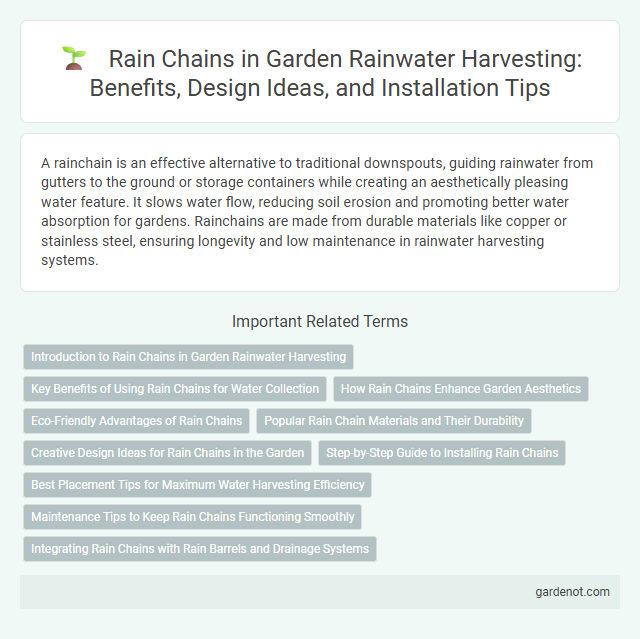A rainchain is an effective alternative to traditional downspouts, guiding rainwater from gutters to the ground or storage containers while creating an aesthetically pleasing water feature. It slows water flow, reducing soil erosion and promoting better water absorption for gardens. Rainchains are made from durable materials like copper or stainless steel, ensuring longevity and low maintenance in rainwater harvesting systems.
Introduction to Rain Chains in Garden Rainwater Harvesting
Rain chains are decorative alternatives to traditional downspouts, guiding rainwater from gutters to garden catchments with visual appeal and functionality. Made from materials such as copper, aluminum, or stainless steel, rain chains slow water flow, reducing soil erosion and enhancing water infiltration into the ground. Their design not only facilitates efficient rainwater harvesting but also adds an aesthetic element to garden landscapes.
Key Benefits of Using Rain Chains for Water Collection
Rainchains offer an efficient and visually appealing method for rainwater harvesting by guiding water flow from rooftops to storage containers while minimizing splash and soil erosion. Their design enhances water collection efficiency, reducing runoff and promoting sustainable water management for gardens and irrigation. Rainchains also reduce maintenance compared to traditional downspouts by preventing clogging and encouraging natural water filtration through cascading droplets.
How Rain Chains Enhance Garden Aesthetics
Rain chains transform ordinary downspouts into captivating water features, adding a visually appealing element to garden landscapes. Their elegant design and the soothing sound of cascading water create a tranquil ambiance that enhances outdoor spaces. By directing rainwater efficiently, rain chains also support sustainable gardening practices while complementing various architectural styles.
Eco-Friendly Advantages of Rain Chains
Rain chains offer an eco-friendly alternative to traditional downspouts by guiding rainwater gently from rooftops to storage containers or gardens, reducing soil erosion and water waste. Made from durable, non-toxic materials such as copper or stainless steel, rain chains minimize environmental impact while enhancing water conservation efforts. Their ability to slow water flow encourages natural infiltration and replenishment of groundwater, supporting sustainable landscaping practices.
Popular Rain Chain Materials and Their Durability
Popular rain chain materials include copper, aluminum, stainless steel, and bamboo, each balancing aesthetic appeal with functional durability. Copper rain chains offer excellent corrosion resistance and develop a charming patina over time, while aluminum rain chains provide a lightweight, rust-proof alternative suitable for various climates. Bamboo rain chains, though less durable, bring a natural, eco-friendly option ideal for temperate regions, whereas stainless steel combines strength and longevity, resisting weather-related wear effectively.
Creative Design Ideas for Rain Chains in the Garden
Rain chains transform traditional downspouts into artistic water features, combining functionality with aesthetic appeal in garden spaces. Creative design ideas include using copper cups, bamboo links, or recycled glass elements to channel water while adding visual interest and ambient sound. Incorporating vibrant colors, unique shapes, and plant integration around the rain chain enhances the overall garden design and supports sustainable rainwater harvesting practices.
Step-by-Step Guide to Installing Rain Chains
Installing rain chains involves selecting a durable material like copper or aluminum for optimal corrosion resistance and aesthetic appeal. Begin by removing the traditional downspout and securely attaching the rain chain to the gutter outlet using a mounting ring or hook, ensuring it hangs straight to guide water flow effectively. Anchor the bottom end to a rainwater basin or decorative container, and test the setup by running water through it to check for proper drainage and noise reduction.
Best Placement Tips for Maximum Water Harvesting Efficiency
Install rainchains directly beneath downspouts to ensure optimal water flow from roofs into collection systems. Position them where water runoff is most concentrated, such as corners or edges of the roof, to capture maximum rainfall. Ensure the area below the rainchain is properly sloped or equipped with a rainwater storage container to prevent water pooling and maximize harvesting efficiency.
Maintenance Tips to Keep Rain Chains Functioning Smoothly
Regularly clear debris such as leaves and dirt from rain chains to prevent clogging and ensure smooth water flow. Inspect connections and attachment points periodically to avoid corrosion and secure stability during heavy rainfall. Applying a protective sealant on metal rain chains helps reduce rust and extends their lifespan.
Integrating Rain Chains with Rain Barrels and Drainage Systems
Rain chains enhance rainwater harvesting by guiding water from gutters directly into rain barrels, minimizing splashing and maximizing collection efficiency. Integrating rain chains with drainage systems controls runoff by directing excess water safely away from foundations, reducing erosion and flooding risks. This combination optimizes water conservation efforts while maintaining effective landscape drainage.
Rainchain Infographic

 gardenot.com
gardenot.com